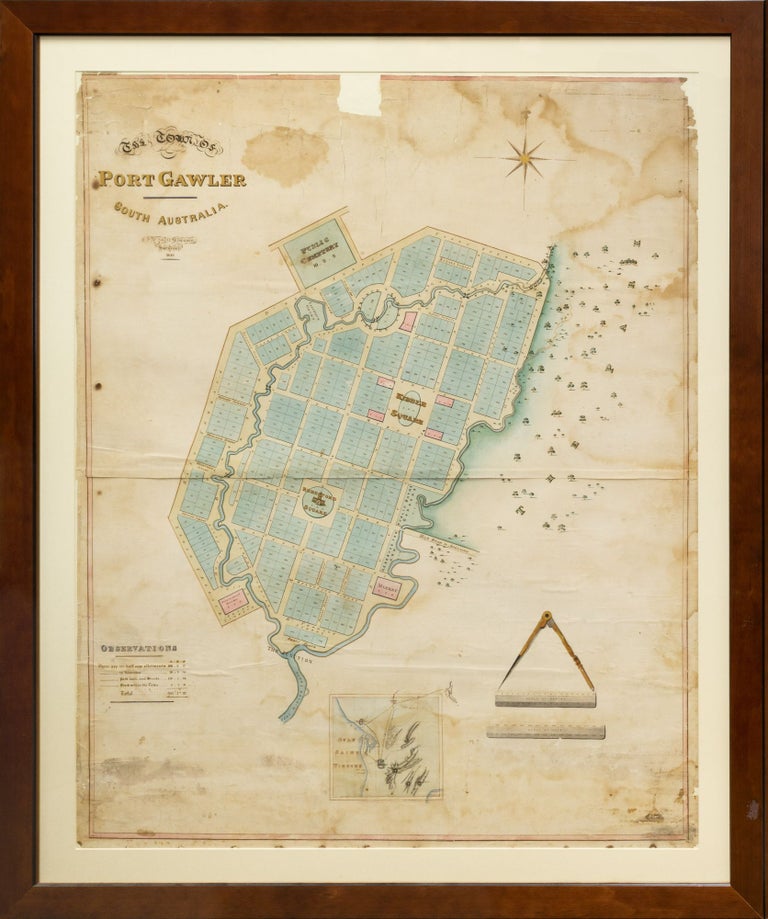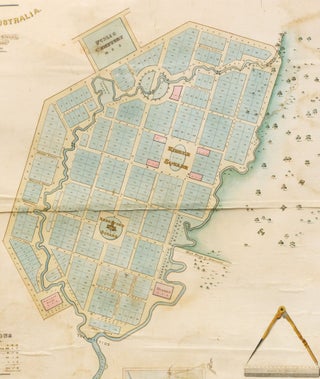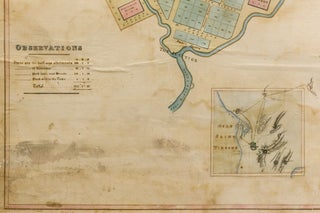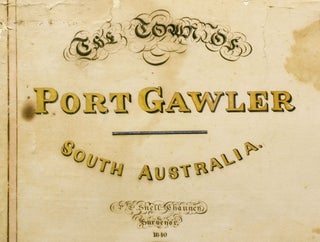A very large hand-coloured manuscript plan of 'The Town of Port Gawler, South Australia', proposed in great detail but never realised
[Adelaide], P.L. Snell Chauncy, Surveyor, 1840.
An extensively hand-coloured map on paper, recently mounted, matted, glazed and framed (visible image size approximately 1220 × 975 mm, external dimensions 1440 × 1200 mm). There is also a small inset map showing the location of the town in relation to Gawler, Mt Barker, Adelaide and the gulf (approximately 165 × 180 mm).
Small plain piece missing from the top edge; trifling marginal loss; some staining, basically inoffensive and fortunately not affecting the plan of the town proper; recent conservation and framing has ensured this unique artefact is an exhibition piece of the highest quality.
This magnificent production relates to perhaps the most infamous fraudulent property speculation in the early years of the colony of South Australia. The site of the proposed township of Port Gawler lay on property known as the Milner Estate, owned by George Milner Stephen, Colonial Secretary and brother-in-law of Governor John Hindmarsh. In an attempt to artificially inflate the value of the property, Stephen placed a flurry of advertisements in South Australian newspapers (some apparently under pseudonyms), making false claims about the situation of the town, the frequency of transport and the quality of natural resources. His campaign initially paid off. In April 1839 Stephen boasted to Adelaide's governing elite and to the newspapers that he had sold half of the Estate to Captain William Allen and Captain John Ellis for the staggering price of £20,000, and that he valued the whole property at £40,000. The sale was soon announced in the 'South Australian Gazette and Colonial Register' of 13 April 1839. 'These gentlemen, in conjunction with Mr Stephen, intend to lay out a large sum in erecting buildings, saw-mills, &c. and are about to commence agricultural operations on an extensive scale forthwith. The demand for allotments in the town of Milner continues to increase. Mr Bensham, the agent, has sold nearly one fourth of the whole within the last three days'. It soon emerged that fewer than 20 of over 200 allotments had sold, and that the sale price was in fact £8000 for two thirds of the estate (see the 'South Australian Register', 23 May 1856, for a later summary). The affair became a scandal in the new colony, with extensive coverage of Stephen's subsequent defamation actions and his resulting trial for perjury. The elaborate plan, with its detailed design for a new township, was commissioned by Captains Allen and Ellis soon after they took sole ownership of the property - now renamed the Port Gawler Estate - in January 1840 ('Southern Australian', 30 April 1840). It shows that they must have retained the hope of marketing and developing the township despite the scandal. However, what with the ongoing circus relating to Stephen's conduct still a hot topic in the press (and before the courts!) this detailed plan appears never to have been published or publicised. They must also soon have learnt that the site was often subject to heavy flooding, and that the Gawler River (with its mangroves and silted-up mouth) was unsuitable for a port. Ellis and Allen contracted surveyor Philip Lamothe Snell Chauncy to prepare the plan. His journal (held by the State Library of New South Wales) indicates that his survey was undertaken in July and August of 1840. The plan is well got up, and comprises 377 half acre allotments as well as parks, reserves and squares (the three principal ones being Prince Albert Circus, Beresford Square and Kibble Square). The town was to be built in section 7500 of the Hundred of Port Gawler, on what is now a seasonal creek and mud flat approximately 4.5 km upstream from the later government town of Port Gawler, named in 1867. 'It was surveyed in 1869 and a large property of 4000 acres named Buckland Park was established along the river. The township and Lisbon Wharf became an important shipping point for grain and other produce with over 100 shallow draft ships called ketches taking their cargo to Port Adelaide. In 1920 fire destroyed the wharf and it was never rebuilt as a nearby rail link to Port Adelaide was constructed' ('Naturally South Australia', online). 'The South Australian Government Gazette' of 23 June 1960 announced that the 'Town of Port Gawler declared to cease to exist'. Important details of the scandal are to be found in ' Pastoral Pioneers of South Australia' (Volume 1, 1925, page 70): 'South Australia had not been long proclaimed a British province when Captain Ellis decided to settle here, hoping, in this new land, to amass wealth that would enable him to buy back an English estate which he had expected to come to him from a bachelor uncle who broke the entail and left it to his butler. He arrived from England by the ship "Buckinghamshire" on March 22, 1839, having as a fellow passenger Captain William Allen of the East India Company, who became a founder of St. Peter's college [sic] and a generous benefactor to the Church of England. Captains Allen and Ellis agreed to enter into partnership. Soon after landing these young enterprising colonists, evidently possessed of considerable means, made large purchases of land, including two-thirds of the "Milner Estate," comprising 4,000 acres, at Port Gawler. This included what has for many years been known as Buckland Park. Proceedings in connection with the purchase of the estate from Mr. G. Milner Stephen (who had been Advocate General, sometimes Acting Governor, and then Colonial Secretary) formed the subject of a notable trial in the Adelaide Courts of the time. Mr. Stephen brought an action for libel against "The Register," but lost the suit. The victorious editor of the journal was Mr. George Stevenson, who had edited the London "Globe" after Gorton's death. He came out as private secretary to the first Governor, and was Clerk of the Council. The Port Gawler or Hummocks estate, as it was designated, stretched from Salisbury to above Port Wakefield. The two captains are credited with having been the first to stock the country towards the Hummocks. A brick dwelling was built on the hill above the present Buckland Park house, on the Little Para River. The bricks were imported as ballast in Captain Ellis' ships, and those used to put in small dams in the river are said to be still there. Captain Ellis laid out the original garden at Buckland Park house. About 1855 he purchased Captain Allen's interest in the property. He sold the estate to the Browne family, but took it back on account of alleged scab infesting the sheep. A year later the Brownes rebought the property at a considerable advance on the original price. Captain Ellis owned a couple of small sailing ships, and brought horses, cattle, sheep and pigs, working plant, and stores from England for several years, until his pastoral interests were thoroughly established'. Fortune favours the bold - and the rich. The two Captains barely took a step backwards with this disastrous investment: 'In 1845 Captain Allen joined other capitalists in the purchase of the Burra copper mine. His partner also became largely interested in this venture, and Captain Ellis was understood to have got out at the top of the boom, having profited in this speculation alone to the extent of a quarter of a million sterling.... In 1867 he retired to live in England. He was then a very rich man. He had lost the inclination to buy his old family estate. The ex-butler, who reigned in his stead, offered, as a gift, all the family portraits in the mansion, and the Australian pastoral king is reported to have used expressive language in indignant reply'. A much more recent account of Port Gawler by Derek Whitelock ('Gawler', 1989, page 265) removes any delusions that this was never more than pie in the swamp: 'Port Gawler never became the thriving township a group of speculators and land jobbers promised it would be when they had a special survey made in the early days and made a great deal of money from people who invested in building blocks that were inundated at high tide, or when the Gawler River was in flood. Menge's dream of shipping on the Gawler river from its silted up estuary among the mangroves right through Gawler Town and up the Valley was one of his more fantastic ones. However, some wheat was moved from the wharves at Port Gawler, lightered out over the shallows to ketches and schooners moored further out. Fortunately for those who like a bit of fishing, mangrovey solitude and wide seascapes, nature at Port Gawler was too intractable for development'. Provenance: Buckland Park, through its succession of owners (the land is now in the hands of property developers); by descent.
Item #127796
Sold




